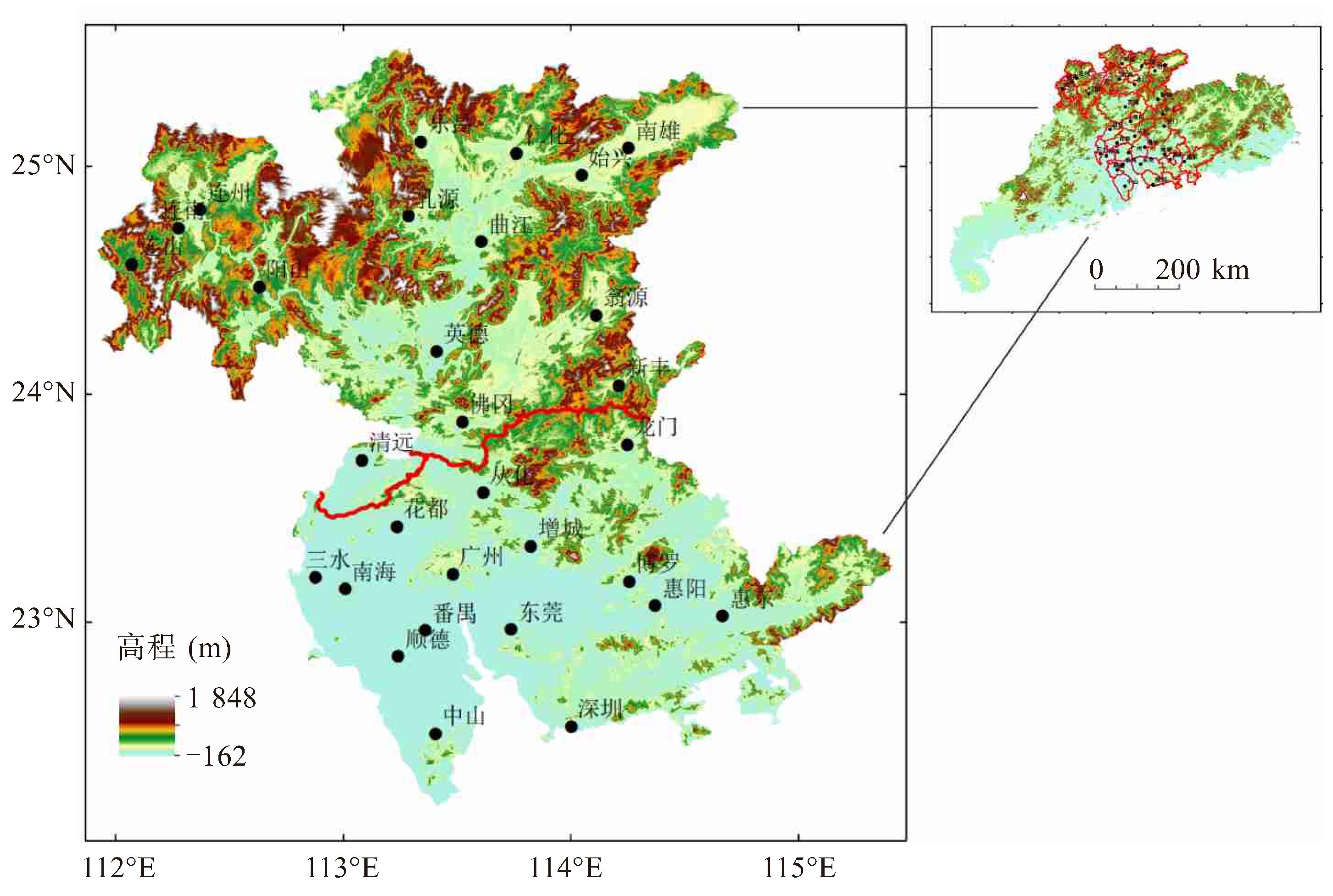COMPARATIVE ANALYSIS OF GROUND-AIR TEMPERATURE DIFFERENCE BETWEEN NORTHERN GUANGDONG AND PEARL RIVER DELTA FROM 1970 TO 2021
-
摘要: 利用1970—2021年粤北和珠三角地区30个气象站的逐日地面温度和气温资料,分析了地气温差(地面温度-气温)空间分布、季节变化及气候变化背景下的年际变化趋势。(1) 近50年来粤北和珠三角年平均地气温差介于1.97~3.21 ℃之间,总体呈现北高南低的纬向型分布格局。(2) 夏季地气温差最大为3.25 ℃,冬季最小为1.71 ℃;其中冬季珠三角地气温差比粤北大,夏季则相反。(3) 珠三角的东莞在冬、夏两季均为下降趋势最明显的城市,降速为0.35 ℃/(10 a)和0.66 ℃/(10 a);上升最明显位于珠三角的增城和粤北的仁化分别为0.30 ℃/(10 a)和0.32 ℃/(10 a)。(4) 近50年粤北和珠三角年平均地气温差呈不显著的下降趋势,降速为0.061 ℃/(10 a);其中粤北呈上升趋势,升速为0.3 ℃/(10 a);珠三角则呈下降趋势,降速为0.16 ℃/(10 a);两者变化趋势呈南北反相分布态势。(5) 粤北地气温差月变化呈单峰型结构,珠三角则呈双峰型结构;两地地气温差最小值在汛期前的3月,粤北峰值在7月,珠三角峰值在7月和10月。此外,珠三角年平均气温及夏季地气温差均在1992年发生突变。粤北和珠三角地气温差在时空分布上存在不同程度的差异。Abstract: Using the daily ground temperature and air temperature data from 30 meteorological stations in northern Guangdong and the Pearl River Delta from 1970 to 2021, the present study analyzed the spatial distribution, seasonal changes, and interannual changes of ground-air temperature difference (surface temperature minus air temperature) under the background of climate change. The results show that: (1) The annual average ground-air temperature difference between northern Guangdong and the Pearl River Delta in the past 50 years is between 1.97 and 3.21 ℃, showing a zonal distribution pattern with higher temperature in the north and lower temperature in the south. (2) The maximum ground-air temperature difference is 3.25 ℃ in summer and the minimum is 1.71 ℃ in winter. The temperature difference in the Pearl River Delta in winter is larger than that in northern Guangdong, while in summer it is the opposite.(3) Dongguan in the Pearl River Delta is the city with the most obvious downward trend in winter and summer, with decline rates of 0.35 ℃/(10 a) and 0.66 ℃/(10 a), respectively. By contrast, the most obvious increase is found in Zengcheng in the Pearl River Delta and Renhua in northern Guangdong, with increase rates of 0.30 ℃/(10 a) and 0.32 ℃/(10 a), respectively. (4) In the past 50 years, the annual average ground-air temperature difference between northern Guangdong and the Pearl River Delta has shown an insignificant downward trend, with a decrease rate of 0.061 ℃/(10 a). An increasing trend is found in northern Guangdong with an increase rate of 0.3 ℃/(10 a), whereas a downward trend is found in the Pearl River Delta with a decrease rate of 0.16 ℃/(10 a). (5) The monthly variation of the ground-air temperature difference in northern Guangdong has a single-peak structure, while that in the Pearl River Delta has a double-peak structure. The minimum ground-air temperature difference between the two places is in March, the peak in northern Guangdong is in July, and the peak in the Pearl River Delta is in July and October. Moreover, the annual average temperature and the ground-air temperature difference in summer in the Pearl River Delta both changed abruptly in 1992. There are differences in the spatio-temporal distribution of ground-air temperature difference between northern Guangdong and the Pearl River Delta.
-
表 2 粤北、珠三角的气温、地面温度和地气温差线性趋势变化
趋势/(℃/(10 a)) 季节 冬季 春季 夏季 秋季 秋季 粤北 气温 0.25* 0.22* 0.11* 0.24* 0.24* 地面温度 0.29* 0.27* 0.07* 0.27* 0.27* 地气温差 0.05 0.06 -0.03 0.04 0.04 珠三角 气温 0.34* 0.26* 0.21* 0.39* 0.39* 地面温度 0.29* 0.12 -0.04 0.19* 0.19* 地气温差 -0.04 -0.13* -0.25* -0.19* -0.19* 注:标*为通过0.05的显著性检验数据。 表 1 粤北和珠三角各年代地气温差变化及其线性趋势
地区 各年代地气温差平均值/℃ 线性倾向率/(℃/(10 a)) 1971—1980 1981—1990 1991—2000 2001—2010 2011—2020 粤北 2.6 2.6 2.5 2.6 2.7 0.02 珠三角 2.7 2.5 2.0 1.9 2.1 -0.17 华南[6] 3.2 3.2 3.0 3.0 3.0 -0.09 表 3 近50年粤北、珠三角地气温差突变特征
地区 季节 冬季 春季 夏季 秋季 全年 粤北 气温 信噪比 0.348 8 0.609 0 0.420 5 0.590 4 0.891 0 突变年份 1986 1996 1993 1997 1997 地面温度 信噪比 0.361 9 0.602 7 0.125 4 0.466 9 0.812 1 突变年份 1996 1996 2002 2002 1997 地气温差 信噪比 0.142 5 0.333 9 0.170 4 0.048 8 0.131 9 突变年份 2007 1995 1992 2002 2006 珠三角 气温 信噪比 0.496 6 0.635 4 0.974 9 0.840 4 1.152 0* 突变年份 1986 1996 1993 1997 1996* 地面温度 信噪比 0.369 4 0.300 2 0.128 8 0.343 0 0.511 2 突变年份 1998 1996 1992 1995 1997 地气温差 信噪比 0.185 3 0.311 2 1.168 9* 0.769 9 0.934 3 突变年份 1988 1991 1992* 1992 1991 注:标*为通过信噪比检验数据。 -
[1] 林良勋, 冯业荣, 黄忠, 等. 广东省天气预报手册[M]. 北京: 气象出版社, 2006: 1-125. [2] 范丽军, 韦志刚, 董文杰. 西北干旱地区地气温差的时空特征分析[J]. 高原气象, 2004, 23(3): 360-367. [3] 陆晓波. 我国地温变化特征及其他气温差与环流异常和夏季降水的相关分析[D]. 南京: 南京信息工程大学, 2006: 1-64. [4] 杨晓玲, 丁文魁, 李岩瑛, 等. 近50年武威市地气温差变化趋势及其影响因子[J]. 生态学报, 2015, 35(8): 2 719-2 725. [5] 顾欣, 张艳梅, 黄大卫. 近50年来黔东南地区浅层地气温差的时空特征分析[J]. 中国农业气象, 2012, 33(1): 71-77. [6] 廖要明, 陈德亮, 刘秋锋. 中国地气温差时空分布及变化趋势[J]. 气候变化研究进展, 2019, 15(4): 374-384. [7] 张应华, 宋献方. 水文气象序列趋势分析与变异诊断的方法及其对比[J]. 干旱区地理, 2015, 38(4): 625-665. [8] 周刊社, 罗驌翾, 杜军, 等. 西藏高原地温对气温变化的响应[J]. 中国农业气象, 2015, 36(2): 129-138. [9] 李玉梅, 彭玉麟, 简茂球, 等. 中国南方地表感热通量的时空变化[J]. 热带气象学报, 2014, 30(6): 1 027-1 036. [10] 周连童. 比较NCEP/NCAR和ERA-40再分析资料与观测资料计算得到的感热资料的差异[J]. 气候与环境研究, 2009, 14(1): 9-20. [11] 沈学顺, 木本昌秀. 春季欧亚大陆地表气温变化特征的气候意义[J]. 大气科学, 2007, 31(1): 19-27. [12] 赵俊芳, 郭建平, 张艳红, 等. 气候变化对农业影响研究综述[J]. 中国农业气象, 2010, 31(2): 200-205. [13] 解晋, 余晔, 刘川, 等. 青藏高原地表感热通量变化特征及其对气候变化的响应[J]. 高原气象, 2018, 37(1): 28-42. [14] ZHOU L T, HANG R H. The interdecadal variability of summer rainfall in Northwest China and its possible causes[J]. Inter Journal Climat, 2010, 30(4): 549-557. [15] 温李明, 周连童, 黄荣辉, 等. 我国东西部地区地气温差的年代际变化特征[J]. 气候与环境研究, 2014, 19(5): 636-648. [16] 陈静林, 杜尧东, 孙卫国, 等. 城市化进程对珠江三角洲地区气温变化的影响[J]. 气候变化研究进展, 2013, 9(2): 123-131. [17] 王林, 刘鹏, 林朝晖, 等. 春季亚洲中东部地表感热通量的变化特征及其与中国夏季降水的关系[J]. 气候变化研究进展, 2011, 16(3): 310-321. [18] 单幸, 周顺武, 王美蓉, 等. 在ENSO不同相位下青藏高原春季感热对华南盛夏降水的影响[J]. 热带气象学报, 2020, 36(1): 60-71. [19] 蔡立梅, 黄兰椿, 周永章, 等. 珠三角洲典型区农业土壤铬的空间结构及分布特征[J]. 农业环境科学学报, 2009, 28(1): 60-65. [20] 李春晖, 何超, 万齐林, 等. 青藏高原热力作用对南海及周边区域夏季气候的影响研究进展[J]. 热带气象学报, 2019, 35(2): 268-280. [21] 王可心, 陈粲, 包云轩, 等. 福建省晋江市城市热岛强度时间空间变化特征分析[J]. 热带气象学报, 2019, 35(6): 852-864. [22] 徐伟, 杨涵洧, 张仕鹏, 等. 上海城市热岛的变化[J]. 热带气象学报, 2018, 34(2): 228-238. [23] 王华, 唐力生, 陈慧华, 等. 气候变化背景下广东冬种生产季气象灾害时空分布特征[J]. 热带气象学报, 2018, 34(4): 570-576. [24] 郑腾飞, 刘显通, 万齐林, 等. 近50年广东省分级降水的时空分布特征及其变化趋势的研究[J]. 热带气象学报, 2017, 33(2): 212-220. -






 下载:
下载:








 粤公网安备 4401069904700003号
粤公网安备 4401069904700003号